Human rights are the foundation of the development of civilization. Only when human rights are promoted and practiced could the world grow and thrive.
In recognition of the importance of human rights, the United Nations proclaimed and sanctioned The Universal Declaration of Human Rights (UDHR) on 10th December 1948. This Declaration is recognized to be the most important piece of document to humans. Translated into over 500 languages and dialects, the Declaration sets out concisely the fundamental rights that every human is lawfully held and protected.
To celebrate the 70th anniversary of the UDHR, Ozge Tigli - the creative director of Bumbuku Creatives in Amsterdam - created a card game in which 30 articles of the Declaration are illustrated vividly and playfully. Tigli's aim is to educate children about human rights through interactive stories in which the kids and their imaginary friends live in the world shaped by the UDHR.
Let's see how 30 articles of the UDHR have been creatively and colorfully incorporated into 30 illustrations by Ozge Tigli below!
Since the issue of child marriage is still prevalent in many countries, Tigli doesn't show the marriage scene in the illustration but replaces it with adult silhouettes in a lovely gathering, which symbolizes happiness and unity. The two owls on the right corner symbolize that this article also includes the right of the LGBTQ+ community, implying that nobody is left out due to their sexual orientation.
H/T: Boredpanda
In recognition of the importance of human rights, the United Nations proclaimed and sanctioned The Universal Declaration of Human Rights (UDHR) on 10th December 1948. This Declaration is recognized to be the most important piece of document to humans. Translated into over 500 languages and dialects, the Declaration sets out concisely the fundamental rights that every human is lawfully held and protected.
To celebrate the 70th anniversary of the UDHR, Ozge Tigli - the creative director of Bumbuku Creatives in Amsterdam - created a card game in which 30 articles of the Declaration are illustrated vividly and playfully. Tigli's aim is to educate children about human rights through interactive stories in which the kids and their imaginary friends live in the world shaped by the UDHR.
Let's see how 30 articles of the UDHR have been creatively and colorfully incorporated into 30 illustrations by Ozge Tigli below!
#1 Article 1: Everyone is born free and equal
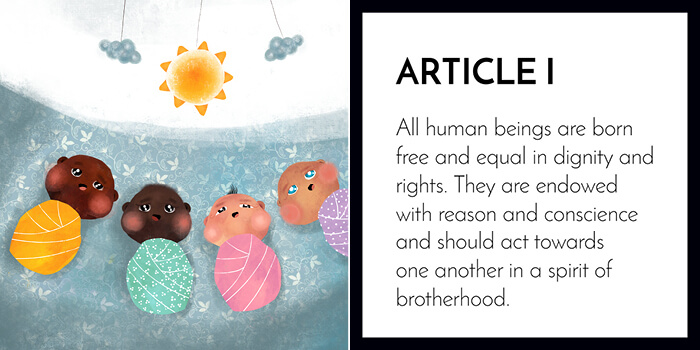 Source: Ozge Tigli
Source: Ozge Tigli
#2 Article 2: Human rights and freedom are for everyone
 Source: Ozge Tigli
Source: Ozge Tigli
#3 Article 3: Security and protection are for everyone
 Source: Ozge Tigli
Source: Ozge Tigli
#4 Article 4: Slavery shall no longer exist
 Source: Ozge Tigli
Source: Ozge Tigli
#5 Article 5: No one shall be tortured or mistreated
 Source: Ozge Tigli
Source: Ozge Tigli
#6 Article 6: Every one of us is recognized as a person
 Source: Ozge Tigli
Source: Ozge Tigli
#7 Article 7: We are all equal before the law
 Source: Ozge Tigli
Source: Ozge Tigli
#8 Article 8: We have the right to seek legal advice and remedy
 Source: Ozge Tigli
Source: Ozge Tigli
#9 Article 9: Unlawful arrest or capture shall not be tolerated
 Source: Ozge Tigli
Source: Ozge Tigli
#10 Article 10: A fair and public hearing is entitled to everyone
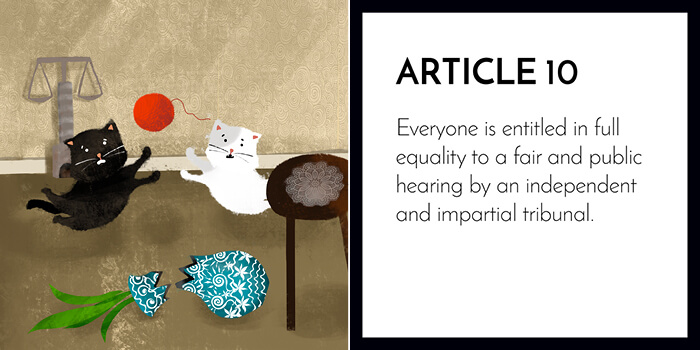 Source: Ozge Tigli
Source: Ozge Tigli
#11 Article 11: The presumption that everyone is innocent until proven guilty
 Source: Ozge Tigli
Source: Ozge Tigli
#12 Article 12: Everyone has the right to protect their privacy from others
 Source: Ozge Tigli
Source: Ozge Tigli
#13 Article 13: Travelling to everywhere you want, it's all your right!
 Source: Ozge Tigli
Source: Ozge Tigli
#14 Article 14: Eveyone has the right to find a new shelter for themselves
 Source: Ozge Tigli
Source: Ozge Tigli
#15 Article 15: Each of us all has our own nationality
 Source: Ozge Tigli
Source: Ozge Tigli
#16 Article 16: Our right to marry and have a family
 Source: Ozge Tigli
Source: Ozge Tigli
Since the issue of child marriage is still prevalent in many countries, Tigli doesn't show the marriage scene in the illustration but replaces it with adult silhouettes in a lovely gathering, which symbolizes happiness and unity. The two owls on the right corner symbolize that this article also includes the right of the LGBTQ+ community, implying that nobody is left out due to their sexual orientation.
#17 Article 17: We have full ownership of our property
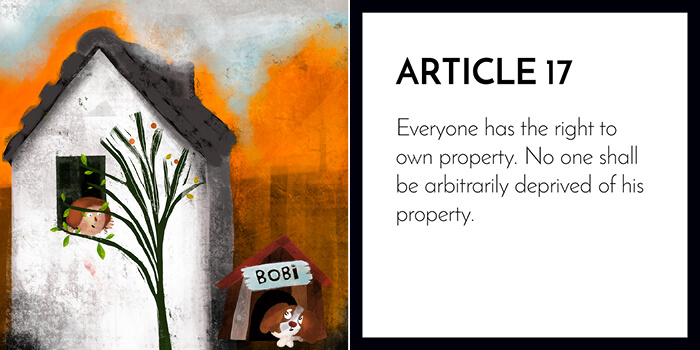 Source: Ozge Tigli
Source: Ozge Tigli
#18 Article 18: Our freedom of thought, conscience, and religion
 Source: Ozge Tigli
Source: Ozge Tigli
#19 Article 19: We can all express our opinion freely
 Source: Ozge Tigli
Source: Ozge Tigli
#20 Article 20: Making friends and joining social groups, they are all our rights
 Source: Ozge Tigli
Source: Ozge Tigli
#21 Article 21: Voting is a basic human right, a foundation for democracy
 Source: Ozge Tigli
Source: Ozge Tigli
#22 Article 22: Economic, social and cultural rights belong to everyone
 Source: Ozge Tigli
Source: Ozge Tigli
#23 Article 23: The right to work and choose a job is all yours
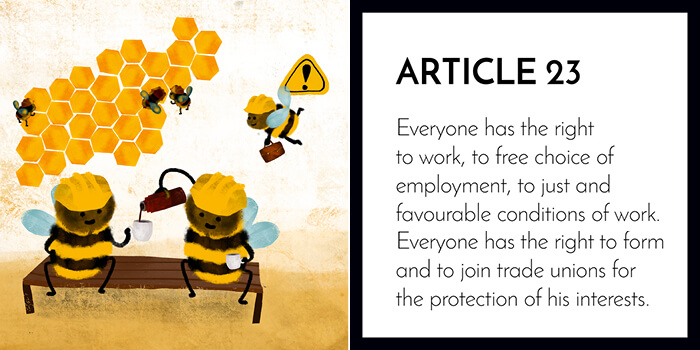 Source: Ozge Tigli
Source: Ozge Tigli
#24 Article 24: Our right to rest and have holidays is recognized too!
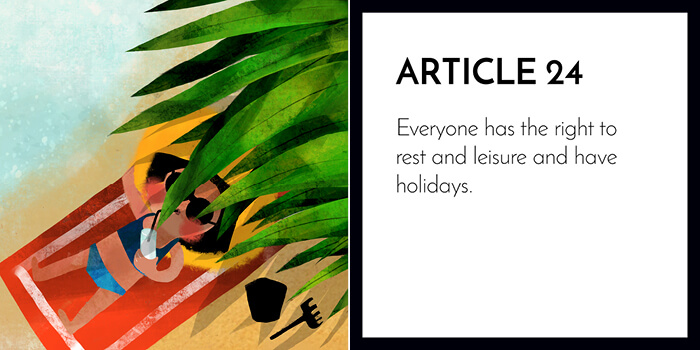 Source: Ozge Tigli
Source: Ozge Tigli
#25 Article 25: An adequate standard of living is entitled to everyone
 Source: Ozge Tigli
Source: Ozge Tigli
#26 Article 26: Education is fundamental to all humans, adult,s and children
 Source: Ozge Tigli
Source: Ozge Tigli
#27 Article 27: We can all enjoy art and science equally
 Source: Ozge Tigli
Source: Ozge Tigli
#28 Article 27: We can all enjoy art and science equally
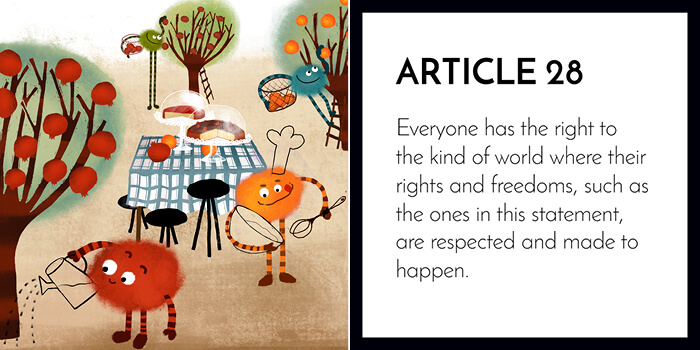 Source: Ozge Tigli
Source: Ozge Tigli
#29 Article 29: Your rights are respected by others, so we must respect other people's rights in return
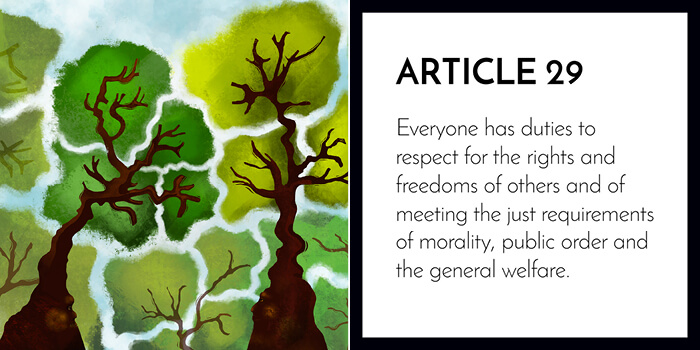 Source: Ozge Tigli
Source: Ozge Tigli
#30 Article 30: Human rights belong to you from the day you were born, and till the last day of your life
 Source: Ozge Tigli
Source: Ozge Tigli
H/T: Boredpanda